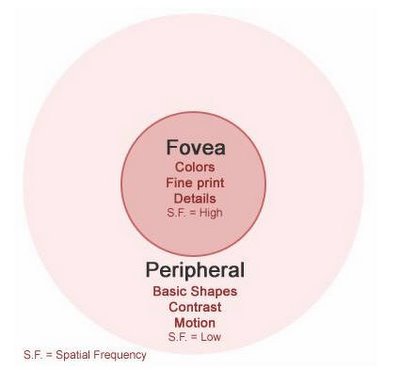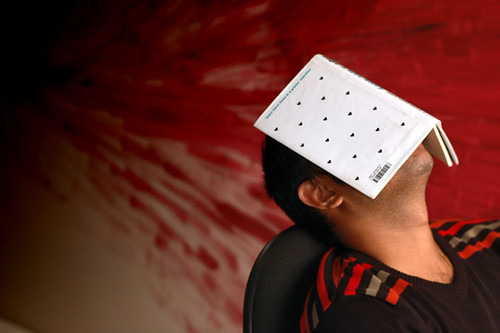Wednesday, February 15, 2006
Mona Lisa – science behind the canvas
Mona Lisa – probably the most celebrated portrait in the world, painted by Leonardo da Vinci between 1503 and 1506 – is at the heart of this article. Almost after 500 years, Mona Lisa is still smiling but the smile is no more mischievous.
If you haven’t experienced her mischievous smile yet, then let me explain the mystery behind it. Mona Lisa is very moody. When you look at her the first time, she smiles at you :) and after some time the smile vanishes… But don’t give up; keep staring at her face and she’ll smile again for a moment.
How this is possible? Almost everybody who sees the portrait raises this question and, no doubt, you can find countless explanations for her animated and ambiguous expression. However, these explanations are not very convincing. After reading various views and explanations, I think it’s important to put down a more concrete explanation in place.
Once again, the search for the most winning explanation ends at ’Human Vision System’. But this time the logic knocks a different door (no “where” or “what” systems like in the previous article).
Using Mona Lisa as an example, we are going to explore the way we look at things. The human eye has its own method for seeing; it always splits vision into two distinct regions:
1. Fovea region
2. Peripheral region
Fovea Region
This is the central spot of your vision, from where your eye collects the most detailed information. This is the area from where the eye can decode perfect colors, read fine print and figure out the fine details. In other words, the object on which you want to focus your vision will be in fovea region, for example, currently the text you are reading is in the fovea region of your vision.
Fovea region works best with high spatial frequency ranges.
Peripheral Region
The area in the surroundings of Fovea comes under Peripheral Region. From this region, eye can’t pick detailed information. Only motion, contrast and low level details (about color, texture and shape) can be seen from this region, for example, while reading this sentence you can see someone moving just few steps away from your desk, but you can’t recognize the person. This is because that person is moving in your peripheral region.
Peripheral region works best with low spatial frequency ranges.
For better understanding, take a look at the following image.
Now let’s talk to Mona Lisa about fovea and peripheral :)
When a person is looking at someone, for the most of the time the eyes are focused on the other person's eyes, which means that his/her eyes are in the scope of our fovea region and the remaining part of face is in peripheral region.
Therefore, when a person's center of vision is on Mona Lisa's eyes, his less accurate peripheral vision is on the surroundings including her mouth. And because peripheral vision is not capable of rendering details, it readily picks up shadows from Mona Lisa's cheekbones. These shadows enhance the curvature near the mouth giving the impression that Mona Lisa is smiling. This can be explained by the fact that her smile is almost entirely in low spatial frequencies and that the peripheral vision is sensitive towards this.
If you move your focus to her mouth, your fovea vision shows more interest in details which are present in high spatial frequencies. These details don’t render shadows (low spatial frequencies) with the same prominence. This is the reason why her smile seems to fade away. :(
So, every time you look at the painting, the new combination of Fovea and Peripheral changes the degree of her smile and you feel the dynamism in her smile.
Following three images show her face to highlight lowest (left), low (middle), and high (right) spatial frequencies.

So, Mona keep smiling, but it’s no more mischievous for us :)
I assume that after reading this article, you’ll be highly interested in knowing more about “Human Vision System”.
All the credit for discovering this science – which can unfold the mystery behind the canvas – goes to the Professor Livingstone. She is working on how cells in the visual system process information and is trying to find a new relation between art and science.

If you haven’t experienced her mischievous smile yet, then let me explain the mystery behind it. Mona Lisa is very moody. When you look at her the first time, she smiles at you :) and after some time the smile vanishes… But don’t give up; keep staring at her face and she’ll smile again for a moment.
How this is possible? Almost everybody who sees the portrait raises this question and, no doubt, you can find countless explanations for her animated and ambiguous expression. However, these explanations are not very convincing. After reading various views and explanations, I think it’s important to put down a more concrete explanation in place.
Once again, the search for the most winning explanation ends at ’Human Vision System’. But this time the logic knocks a different door (no “where” or “what” systems like in the previous article).
Using Mona Lisa as an example, we are going to explore the way we look at things. The human eye has its own method for seeing; it always splits vision into two distinct regions:
1. Fovea region
2. Peripheral region
Fovea Region
This is the central spot of your vision, from where your eye collects the most detailed information. This is the area from where the eye can decode perfect colors, read fine print and figure out the fine details. In other words, the object on which you want to focus your vision will be in fovea region, for example, currently the text you are reading is in the fovea region of your vision.
Fovea region works best with high spatial frequency ranges.
Peripheral Region
The area in the surroundings of Fovea comes under Peripheral Region. From this region, eye can’t pick detailed information. Only motion, contrast and low level details (about color, texture and shape) can be seen from this region, for example, while reading this sentence you can see someone moving just few steps away from your desk, but you can’t recognize the person. This is because that person is moving in your peripheral region.
Peripheral region works best with low spatial frequency ranges.
For better understanding, take a look at the following image.

Now let’s talk to Mona Lisa about fovea and peripheral :)
When a person is looking at someone, for the most of the time the eyes are focused on the other person's eyes, which means that his/her eyes are in the scope of our fovea region and the remaining part of face is in peripheral region.
Therefore, when a person's center of vision is on Mona Lisa's eyes, his less accurate peripheral vision is on the surroundings including her mouth. And because peripheral vision is not capable of rendering details, it readily picks up shadows from Mona Lisa's cheekbones. These shadows enhance the curvature near the mouth giving the impression that Mona Lisa is smiling. This can be explained by the fact that her smile is almost entirely in low spatial frequencies and that the peripheral vision is sensitive towards this.
If you move your focus to her mouth, your fovea vision shows more interest in details which are present in high spatial frequencies. These details don’t render shadows (low spatial frequencies) with the same prominence. This is the reason why her smile seems to fade away. :(
So, every time you look at the painting, the new combination of Fovea and Peripheral changes the degree of her smile and you feel the dynamism in her smile.
Following three images show her face to highlight lowest (left), low (middle), and high (right) spatial frequencies.

So, Mona keep smiling, but it’s no more mischievous for us :)
I assume that after reading this article, you’ll be highly interested in knowing more about “Human Vision System”.
All the credit for discovering this science – which can unfold the mystery behind the canvas – goes to the Professor Livingstone. She is working on how cells in the visual system process information and is trying to find a new relation between art and science.

Comments:
<< Home
Amiable dispatch and this enter helped me alot in my college assignement. Say thank you you as your information.
Sorry for my bad english. Thank you so much for your good post. Your post helped me in my college assignment, If you can provide me more details please email me.
Post a Comment
Subscribe to Post Comments [Atom]
<< Home



